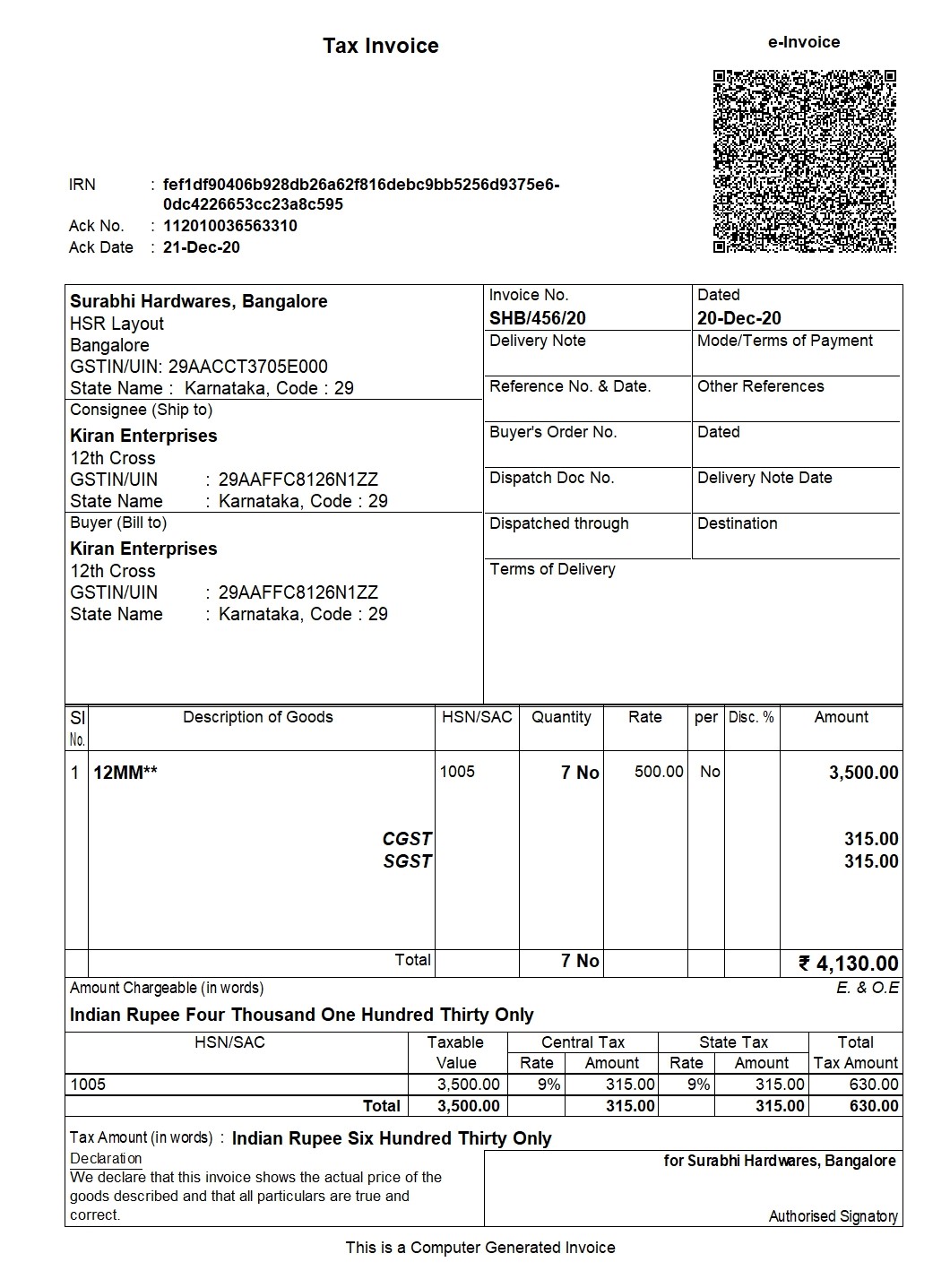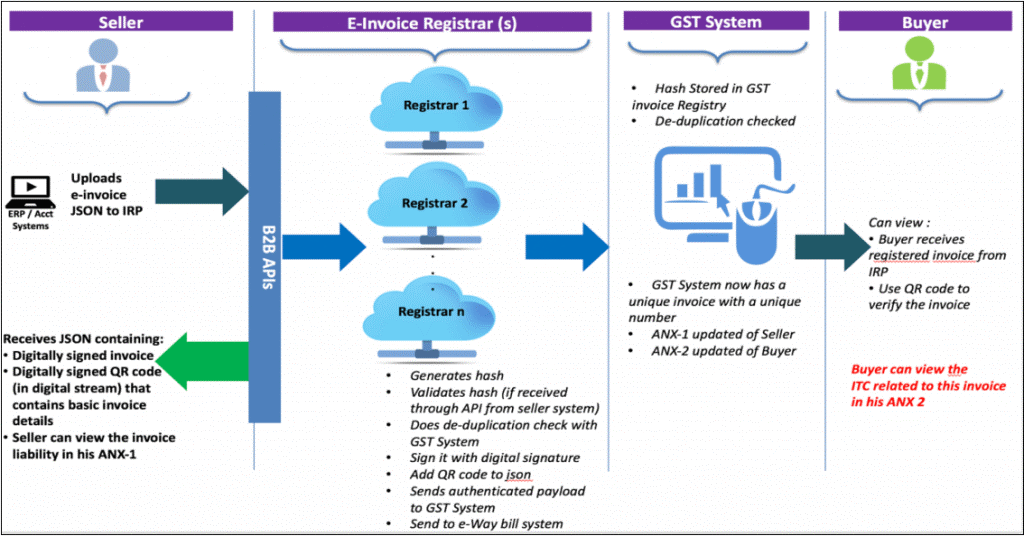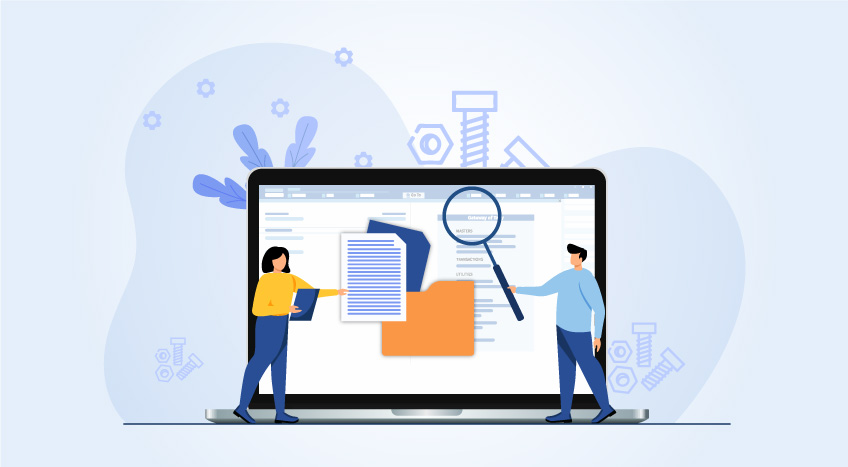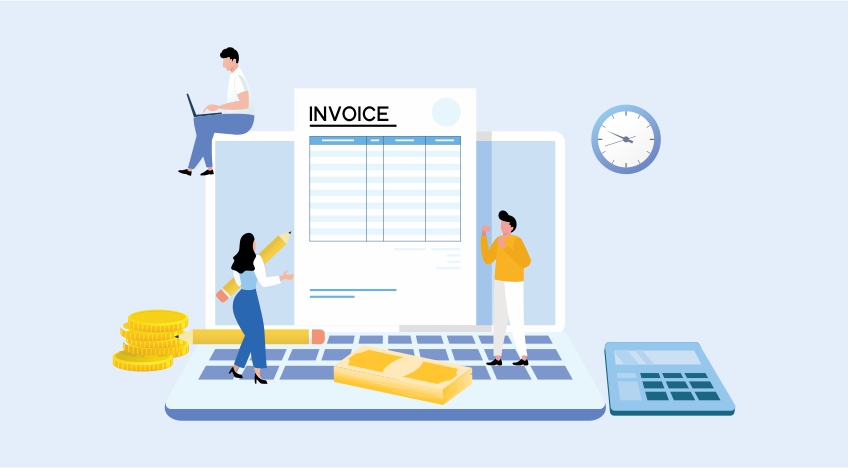Yarab A |Updated on: December 19, 2023
- What is e-invoice under GST?
- Why e-invoicing is introduced?
- What are the benefits of e-Invoice system?
- How will e-invoicing curb tax evasion?
- What are the mandatory fields of an e-invoice?
- What does the e-invoice look like?
- When will e-invoicing be introduced?
- What are the types of documents that are to be reported to the IRP?
- What is the workflow of e-invoice?
- How will the system of e-invoicing be integrated with GST Returns?
- What data will be included in an e-invoice?
- Amendment / cancellation of e-invoices
- What are the benefits of e-invoicing
- Type of business to whom e-invoice will be applicable?
- Who need not comply with e-Invoicing?
- What is the system in place for issuing invoices before e-invoicing?
- Who should upload the e-invoice?
- What type of documents are to be reported to GST system?
- How is e-invoice different from the current practice of invoicing?
- What are the modes of generating e-invoice?
Ever since the concept of e-invoicing was approved by the GST council, the buzz around e-invoicing has gained importance among the business community. The introduction of e-invoicing was approved by the GST council at its 37th meeting held in the month of September,2019 with the key objective to ensure inter-operability of e-invoices across the GST eco-system.
Invoice being a key document and e-invoicing being a reform related to it, it is super important for businesses to understand it fully and accordingly prepare towards to it.
In this article, let’s discuss and understand everything about e-invoicing under GST.
What is e-invoice in GST?
e-Invoice known as ‘Electronic invoicing’ is a system in which all B2B invoices are electronically uploaded and authenticated by the designated portal.
| Best e-Invoicing Software Solution for Businesses in India | Generate e-Invoice Instantly in TallyPrime |
Post successful authentication, a unique Invoice Reference Number (IRN) is generated for each invoice by IRP. Along with IRN, each invoice is digitally signed and added with a QR code. This process is collectively called e-invoicing under GST
Know more on IRN, Format and process to generate it.
When will e-invoicing be introduced?
To ensure that businesses get enough time to adapt to the new system of electronic invoicing, the GST Council has approved the introduction of e-invoicing in a phased manner.
|
Annual turnover |
New date of mandatory implementation of e-invoice |
|
Exceeding 500 crore |
1st October 2020 |
|
Exceeding 100 crore |
1st January 2021 |
|
Exceeding 50 crore |
1st April 2021 |
|
Exceeding 20 crore |
1st April 2022 |
|
Exceeding 10 crore |
1st October 2022 |
|
Exceeding 5 crore |
1st August 2023 |
In the recent update, from 1st August 2023, e-Invoicing will be essential for all the registered persons whose aggregate turnover (based on PAN) in any prior fiscal year from 2017-18 onwards exceeds 5 crores.
Why e-Invoicing is introduced?
In spite of invoices generated by each software look more or less the same, the computer system can’t understand it, though the business users can understand them fully. For example, an invoice generated by accounting Software “A” cannot be read by a machine that is using “B” accounting software.
Today, there are hundreds of accounting/billing software that generates invoices and all of them have their own formats to store the information. Owing to this, the GST system can’t read and understand these invoices, although the information in the invoice remains the same.
To cut the long story short, today the same information is presented in different invoice formats and there is no way a system can understand it.
Hence, a need was felt to standardize the format in which electronic data of an invoice will be shared with others to ensure there is interoperability of the data.
What are the benefits of e-Invoice system?
The basic aim behind the adoption of the e-invoice system is to pre-populate the returns and reduce the reconciliation challenges. This is achieved by the design of the IRP system which shares the invoice data to the GST system and e-way bill system. Thus, continuous uploading of invoices will ensure that most of the details required in returns as well in the e-way bill get auto-populated.
The following are some of the key benefits of e-invoicing:
- Reduces reporting of same invoice details multiple times in different forms. It’s just a one-time upload and everything, as required, will get pre-populated.
- Part-A of e-Way bill will be auto-captured and only transporter details are required to be updated.
- On uploading of invoices, the B2B details will be auto-captured in GSTR-1 return.
- Substantial reduction in input credit verification challenges as the same data will get reported to the tax department as well to the buyer in his inward supply (purchase) register (GSTR-2A).
- On receipt of info from the GST System, a buyer can do a reconciliation with his Purchase register and accept/reject it on time under New Return.
- A complete trail of B2B invoices and system-level matching of input credit and output tax helps to reduce tax evasion
- Increase efficiency in tax administration by eliminating fake invoices.
Related Articles
- Benefits of e-Invoicing in Post Pandemic
- Business Impact of e-Invoice
- Critical Challenges to the New E-Invoicing System
How will e-invoicing curb tax evasion?
Many benefits of e-invoicing exist and one of them is its ability to curb tax evasion. With an e-invoice, the chances of editing invoices will be low because before any transaction is done, the invoice gets generated. Another reason why e-invoice system is helpful is that it ensures the authorities have information about all the transactions in real-time. E-invoicing greatly minimizes fake GST invoices and ensures that input tax credit is claimed on real GST invoices due to automation and thorough checks. If someone tries to claim a fake tax credit, then it is easy for GSTN to track them.
What are the mandatory fields of an e-invoice?
The following are the 30 mandatory fields of an e-invoice. Earlier, 50 fields were to be mandatorily filled by the taxpayer.
|
Field name |
Description |
|
Document Type Code |
Every type of document has a code and this must be specified in this portion. |
|
Supplier Legal Name |
The name of the supplier according to the PAN card details. |
|
Supplier GSTIN |
The supplier GSTIN for e-invoice. |
|
Supplier Address |
The full address of the supplier including flat number, building no. etc. |
|
Supplier Place |
The city/village/town of the supplier must be specified here. |
|
Supplier State Code |
The state must be selected. |
|
Supplier Pincode |
The six-digit pin code of the supplier’s address. |
|
Document Number |
A unique invoice number that makes sense to the business. It has to be sequential for easy identification. |
|
Preceding Invoice Reference and Date |
The original invoice details are being edited using a document such as a credit note. |
|
Document Date |
The date on which the invoice was issued. |
|
Recipient Legal Name |
The name of the buyer is specified as per his PAN card. |
|
Recipient’s GSTIN |
The buyer’s GSTIN needs to be specified. |
|
Recipient’s Address |
The detailed address of the buyer has to be specified. |
|
Recipient’s State Code |
The place of supply has to be specified. |
|
Place of Supply State Code |
The state of the recipient has to be selected. |
|
Pincode |
The location of the recipient has to be selected. |
|
Recipient Place |
The village/town/city of the recipient has to be specified. |
|
Invoice Reference Number or IRN |
The supplier leaves the field empty at the time of registration, and after that, GSTIN generates a unique number when the e-invoice is uploaded on the GSTN portal. As the e-invoice is accepted, acknowledgment is sent. Before the use of an e-invoice, the IRN has to be displayed on it. |
|
Shipping To GSTIN |
GSTIN of the person the item is being delivered to. |
|
Shipping To State, Pincode and State Code |
This field specifies the place where the goods and services are delivered. |
|
Dispatch From Name, Address, Place, and Pincode |
The name of the dispatching entity, along with the city/town/village specifics. |
|
Is Service |
If the supply of service has to be specified. |
|
Supply Type Code |
The type of supply and its responding code is specified. It can be supplied to SEZ, B2B, etc. |
|
Item Description |
The item’s description. |
|
HSN Code |
The particular code for the goods or services. |
|
Item Price |
The GST exclusive unit price prior to the item price discount being subtracted. This value must be positive. |
|
Assessable Value |
The item’s price excluding GST and after the item price discount has been subtracted. |
|
GST Rate |
The rate of the specific item for which the invoice has been generated. |
|
IGST Value, CGST Value and SGST Value Separately |
Every item must have IGST, SGST, and CGST. |
|
Total Invoice Value |
The total value, including GST. |
What does the e-invoice look like?
The e-invoice format shared by the GSTN is the one that must be used by all businesses. The e-invoice must mandatorily have all the fields, both mandatory and non-mandatory details as specified. It must be noted that the mandatory fields have to be filled by all taxpayers. In cases where it applies, the non-mandatory fields are required to be filled by the taxpayer. An e-invoice looks like the following.

Related Articles
- How does e-Invoice System Work
- How to amend or modify e-invoices?
- How to Transit to e-Invoice System?
- Things to consider while choosing an e-invoice solution
What are the types of documents that are to be reported to the IRP?
The following documents will be covered under e-Invoicing for now:
- Invoices by the Supplier
- Credit Notes by the Supplier
- Debit Notes by the Recipient
- Any other document as required by law to be reported by the creator of the document
What is the workflow of e-invoice?
- Step 1 – Generation of e-invoice:
The taxpayer will continue to generate invoices in the normal course of business. However, the reporting of these invoices electronically has criteria. It needs to be done as per the e-invoice schema, along with mandatory parameters. The mandatory fields of an invoice for the supply of goods are listed below:
-
- Invoice type
- Code for invoice type
- Invoice Number
- Invoice Date
- Supplier details like Name, GSTIN of Supplier, and Supplier address (including place, pin code, and state)
- Details of the buyer, such as name, GSTIN, state code, address, place, pin code, payee name, account number, payment mode, and IFSC code
- Dispatch details
- Invoice item being dispatched
- Total tax amount paid amount, and payment due
- Tax scheme (whether GST, Excise Custom, VAT)
- ‘Shipping To’ details like Name, GSTIN, address, pin code, state, supply type, and transaction mode (whether regular, ‘bill to’ or ‘ship to’)
- Details of goods like Sl. no., quantity, rate, assessable value, GST rate, amount of CGST/SGST/IGST, total invoice value, batch number/name
The seller has to ensure that his accounting/billing software is capable of generating a JSON of the final invoice. The seller can create a JSON following the e-invoice schema and mandatory parameters by using the following modes:
-
- Accounting and billing system that offers this service
- Utility to interact with either accounting/billing system, ERP, excel/word document, or a mobile app
- Offline Tool to generate e-invoice by keying-in invoice data
- Step 2 – Generation of unique IRN:
The supplier has the option to generate a ‘hash’ based on specific parameters, usually three of them, such as Supplier’s GSTIN, Supplier’s invoice number, Financial Year (YYYY-YY). The prescribed algorithm, such as SHA256 must be used for the hash generation. If the hash is validated, it will later become the Invoice Reference Number (IRN) of the e-invoice.
- Step 3 – Uploading the JSON:
The following modes may be used to upload the JSON of the final invoice:
-
- Directly on the IRP
- Through GST Suvidha Provider (GSP)
- Third-party provided apps (including through API)
- The supplier can also upload the hash along with the JSON onto the IRP if generated by him
- Step 4 – Hash generation/validation:
Hash will have to be generated by the IRP in respect of the invoices uploaded without the hash. In such a case, the hash generated by the IRP would become the IRN. Where the supplier has also uploaded the hash, a de-duplication check will be performed. It is done by validating the hash/IRN against the Central Registry of the GST System to ensure that the IRN is unique. Once validated, the hash/IRN is stored in the Central Registry. IRP will then generate a QR Code and digitally sign the invoice and make it available to the supplier. The IRP also sends the e-invoice via e-mail mentioned on the invoice to the buyer and seller.

Source: last FAQ doc released by GSTN
How will the system of e-invoicing be integrated with GST Returns?
An e-Invoice will be uploaded into the relevant GST return only once it has been validated and registered by the invoice registration system. After the validation has been done, it will be visible to the recipient for viewing and taking action (in the new return system).
The main aim of the tax department is to enable the pre-population of GST returns, which will reduce reconciliation-related problems. Once e-Invoicing has been implemented, the data in the invoices can be pre-populated into the relevant tables of the tax returns without the need for fresh data entry.
What data will be included in an e-invoice?
As per the draft format generated by the GSTN, an e-Invoice will contain the following parts-
- E-invoice schema: This part will consist of the technical field name and the description of each field. It will also specify if a field is mandatory or not and has a few sample values along with explanatory notes
- Masters: Masters will specify the set of inputs for certain fields that are pre-defined by GSTN itself. It includes fields like UQC, State Code, invoice type, supply type, etc.
- e-Invoice template: The template is as per the GST rules and enables the reader to correlate the terms used in other sheets. The mandatory fields are marked in green, and the optional fields are marked in yellow.
Amendment/cancellation of e-invoices
Can an e-invoice be canceled partially/fully?
An e-invoice cannot be partially canceled, it has to be canceled fully. Once you cancel an e-invoice, it has to be reported to the IRN within 24 hours. No cancellation post 24 hours of upload is allowed on the IRN and needs to be manually canceled on the GST portal before the returns are filed.
How can an e-invoice be amended?
All amendments to an e-invoice can be made only on the GST Portal.
What are the benefits of e-invoicing?
- One-time reporting of B2B invoices while generation, which reduces reporting in multiple formats
- Sales and Purchase Registers can be generated from this data, and GST returns can be kept ready for filing under the new return system
- E-way bills can also be generated using e-Invoice data
- There is minimal need for data reconciliation between the books, and GST returns filed
- Real-time tracking of invoices prepared by a supplier can be enabled, along with the faster availability of input tax credits. It will also reduce input tax credit verification issues
- Automation of the tax-filing process
- Reduction in the number of frauds as the tax authorities will also have access to data in real-time
- Elimination of fake GST invoices getting generated
Related Articles
Type of business to whom e-invoice will be applicable?
Electronic Invoicing will be applicable to all the businesses that are registered under GST and issuing B2B invoices in a phased manner as discussed above.
Who need not comply with e-Invoicing?
As per the latest mandate, from 1st August 2023, e-Invoicing will be essential for all the registered persons whose aggregate turnover (based on PAN) in any prior fiscal year from 2017-18 onwards exceeds 5 crores. As of now, businesses with a turnover less than the mandated amount don't need to comply with the e-invoicing norm.
What is the system in place for issuing invoices before e-invoicing?
At that time, businesses had the freedom to issue invoices using any third-party software of their choice. The invoice details than had to be uploaded by the business manually in the GSTR-1 return. When this was completed successfully, the information entered automatically reflected in the GSTR-2A form. This is a view-only form. The transporters had the responsibility of importing the invoices manually to generate e-way bills.
Read Article
Who Should Issue an e-Invoice in GST?
Who should upload the e-invoice?
Under the concept of e-invoice, the seller has to electronically upload the invoice to the IRP system and capture the QR code and IRN (Invoice Reference Number) in the physical copy of the invoice issued to the recipient.
What type of documents are to be reported to the GST system?
The following documents are covered under the concept of e-invoice. Meaning the creator of these documents needs to upload them to the IRP system.
- Invoice by Supplier
- Credit Note by Supplier
- Debit Note by Supplier
- Any other document as required by law to be reported by the creator of the document
How is e-invoice different from the current practice of invoicing?
E-invoice is a system in which the invoice needs to be electronically uploaded and authenticated with a unique invoice reference number (IRN) and digitally signed QR code. The change is that the seller needs to print the QR code and IRN number on the invoice before issuing it to the buyer.
Businesses using ERP/ business management software that seamlessly connects with the IRP system and automatically prints the QR code and IRN on the invoice will find it easy to manage e-invoice requirements without many changes to the business process.
What are the modes of generating e-Invoice?
Multiple modes will be made available so that the taxpayer can use the best mode based on his/her need. The following are different modes of generating e-Invoice.
- Web-Based,
- API Based,
- SMS Based,
- Mobile App
- offline tool based and
- GSP based
Read Articles
- How to Generate e-Invoice in GST?
- Generate e-Invoice Instantly in TallyPrime
- Bulk Generation of e-Invoices in TallyPrime
FAQs on e-invoice
Can an e-invoice be canceled partially/fully?
You cannot cancel an e-invoice partially. If you must cancel the e-invoice, then it must be done completely or fully. When you do this, you must report it to the IRN within 24 hours of the cancellation. If you try to cancel an e-invoice after that period, then you cannot use the IRN. Instead, you need to use the GST portal for cancellation, and it must be done manually. This has to be done prior to filing the returns. When you cancel, you cannot re-use the invoice number, and a new one must be generated else the IRP will reject it.
Read Article
How to cancel e-invoices in GST?
How e-invoice works?
e-Invoicing works in two parts - first is the interaction between the business and IRP, and the second is the interaction between the IRP, the GST/E-Way Bill Systems, and the Buyer.
Why is e-invoicing needed?
E-invoicing helps organizations simplify their invoicing process, thus reducing paperwork and improving the time required for invoice processing.
Is e-way bill required for e-invoice?
Taxpayers have the option of generating an e-way bill when they generate an e-invoice. But they can choose to generate an e-way bill at a later time too. An e-invoice is needed along with an e-way bill to ensure the e-way bill is valid. Many assume that the e-way bill has become obsolete since the introduction of e-invoicing but that is not true. E-way bills are required for the transportation of goods is taking place and it is an important document.
Can we generate an e-invoice for an unregistered person?
The customer, or the unregistered person, will not be claiming an ITC. Currently, there is no provision in place whereby e-invoicing is mandatory for B2C transactions. But a dynamic QR code must be generated for digital payments whereby B2C transactions are concerned. This is mandatory for taxpayers with an aggregate turnover of over Rs. 500 crores since 1st December 2020.
Who should register for e-invoicing?
e-Invoicing has been mandated for businesses with an annual turnover exceeding Rs 10 crore from 1st October 2022, mandating all businesses under the said category to register for e-invoicing. And the businesses with an annual turnover exceeding Rs 5 crore will be mandated to issue e-invoices from 1st August 2023 in any preceding financial year from 2017-2018 onwards.
Where to register for e-invoicing?
All GST-registered taxpayers who are required to generate IRNs should register for e-invoicing using their GSTIN. Additionally, taxpayers who are registered on the e-way bill portal are not required to register on the e-invoice system; instead, they can use their EWB credentials to login.
What is e-invoice registration form?
e-Invoice registration form is the piece of document that you need to register in the e-invoice system.
How to generate e-invoice in the GST portal?
- Visit the e-invoice portal
- Click on the Registration button
- Click on e-Invoice Enablement
- Now, you need to enter the GSTIN of the company
- Post this; you'd need to get the OTP verification done
- Now, you need to enter the annual turnover details with the related financial year and submit
- Now you are registered for e-invoicing
- Now you can log in to the e-invoice portal and upload B2B invoices using a chosen mode to generate IRN
How to upload e-invoice in the GST portal?
- You need to login to your GST account
- Now, select the month for which you want to upload GST invoices
- Post this, select GSTR-1 Return and Click on Prepare Online
- Now you can select B2B invoices and enter details of the invoices one by one
How to print e-invoice in the GST portal?
- Enter invoice details
- preview and confirmation
- Validation and generation of JSON File
- Login to e-Invoice Portal
- Upload JSON file, and generate IRN, and download response file
- Import IRNs in GePP and push to history
- Print e-Invoice
How to modify e-invoice in gst portal?
Watch How to Set-up TallyPrime for e-invoice
Video guide - e-invoicing in TallyPrime
Know more about e-invoices in GST
Latest Blogs

Nuts & Bolts of Tally Filesystem: RangeTree

A Comprehensive Guide to UDYAM Payment Rules

UDYAM MSME Registration: Financial Boon for Small Businesses

Understanding UDYAM Registration: A Comprehensive Guide

MSME Payment Rule Changes from 1st April 2024: A Quick Guide

Are Your Suppliers Registered Under MSME (UDYAM)?


